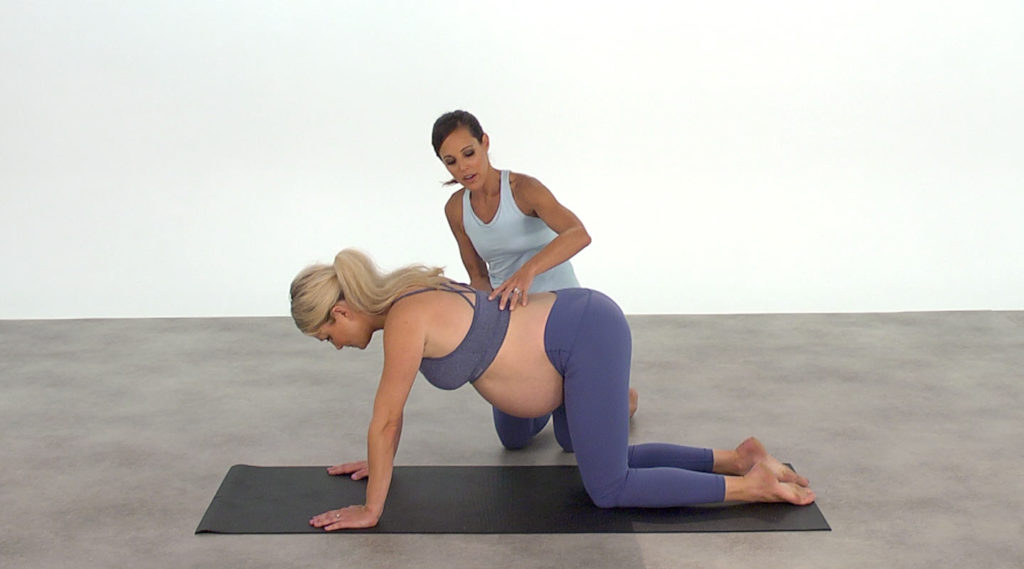
As your belly expands, it may seem counterintuitive to work on strengthening the muscles around that area. After all, it increases in size as a natural part of pregnancy. Before I explain why ab exercises during pregnancy is not counterintuitive, let me tell you what the core is. As simply as possible, your core is defined as all the parts of the body except for your limbs and head. Think of your core as your abs, chest, back, and hips. Post pregnancy, your healthy muscles will bounce back more quickly from labor.
Now we are going to go a little deeper into the core, specifically the transverse abdominis.
The transverse abdominis (TA) supports your baby during pregnancy. The fibers act just like a corset, pulling the core in from all angles (front and back). They are the most important of the muscle groups of the abdomen. The pelvic floor and TA keep your belly from dropping to your toes. The TA and pelvic floor, together with the uterus, work to push your baby out during delivery. Having those muscles be as strong and flexible as possible during labor while greatly ease your baby’s entry into the world and you’ll be grateful for that.
Core muscles are not only important in labor and delivery, but also important in the pregnant woman’s changing center of gravity, postural changes, and muscle imbalances. Keeping the core muscles pliable and strong will decrease common pregnancy discomforts. The TA is responsible for stabilizing your spine and pelvis. So doesn’t it make sense to focus a few abdominal exercises to strengthen?
The transverse is activated throughout the day, sometimes without our noticing. Anytime we step off a curb or trip, the TA is activated unintentionally. When you go to pick up your toddler or turn to grab something off the counter behind you, you should focus on firing the transverse abdominis. Our Prenatal and Postnatal Exercise Guide is full of tips to help you engage these important muscles throughout the day.
Just how do we contract the transverse abdominis?
In our pregnancy programs, we build on this foundational core exercise. We add 9 functional core exercises in the video above. You can try it totally free with a seven day trial of our pregnancy programs.
Before beginning exercise, you must have your doctor’s permission.
Implement functional core exercise during your first trimester to set up core health as your baby grows. In our core workouts, we focus on the transverse abdominis. The main job of this muscle is to stabilize the spine and pelvis before your legs/arms move (think stepping off a curb). So it’s important we make these muscles strong to support your pregnancy.
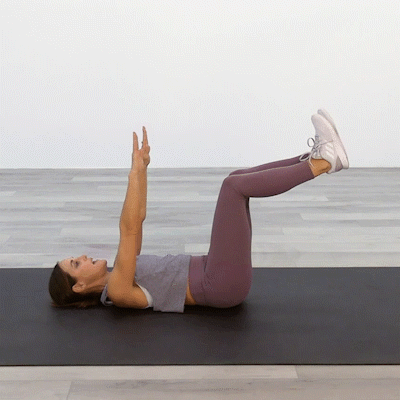
DEAD BUG SWITCH
Begin lying on your back with legs bent. Lift your legs and arms off the ground, keeping your knees bent. Keep your spine neutral, core braced. Lower one arm to the ground and lower your opposite leg at the same time. Repeat with your opposite arm and leg. Continue to alternate. Maintain your low back on the floor and keep abdominals drawn down towards your spine. If you cannot maintain lower back, start by alternating arms. As you become stronger, alternate legs only. Then progress to opposite arm and leg.
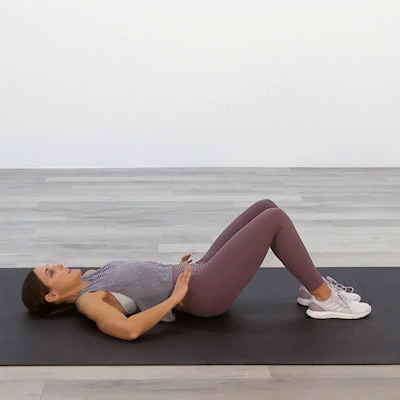
FUNCTIONAL CORE MARCH
Lie on your back with your knees bent and feet resting flat on the floor. Tighten your transverse abs using the TA breath (in the 90 second video above). Without letting your pelvis move, slowly lift one knee to a 90-degree angle, then the other knee. Slowly return to starting position one leg at a time, keeping the pelvis neutral and abs engaged.
The most common question during the 2nd trimester is “should I lie on my back?” As your belly grows, this supine position (lying on your back) can decrease blood flow back to your heart. After 20 weeks gestation — or halfway through your second trimester — this can cause low blood pressure in 10 – 20 percent of pregnant women. Refrain from lying on your back for long periods of time, as well as motionless exercises.
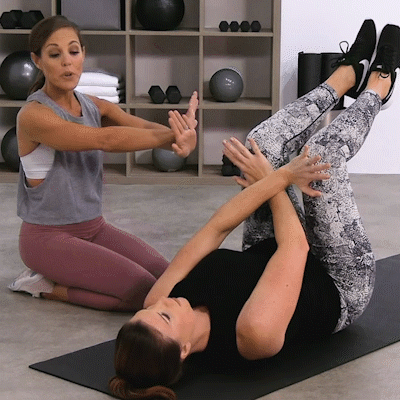
FUNCTIONAL 90-DEGREE ISOMETRIC PUSH
Here we are working your obliques, deep abs, and back muscles in a non-traditional way. Lie on your back with your knees bent to 90-degrees, directly above your hips. Cross your hands so the heel of the palm is pushing against the opposite knee. Without letting your pelvis move, push the heel of the palm into the knee. Switch sides. Inhale, then exhale as you push the palm tightening your transverse abs.
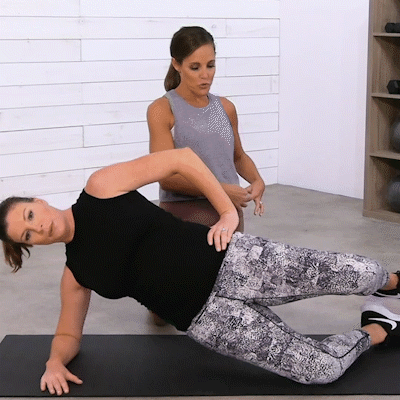
SIDE PLANK TILT
Start in a modified side plank position. Inhale, then exhale as you tighten your transverse abs. Working your core stability, tilt the top hip forward 1 – 4 inches. Your knee will also move forward as your hip tilts forward.
Core exercises should look different in your third trimester. These should be functional exercises, not your “traditional” ab exercises, with a focus on the transverse abdominals and pelvic floor. It is safe to lie on your back for short periods of time, usually 2 – 3 minutes at most. For 10 – 20 percent of pregnant women, lying in this position after 20 weeks gestations can cause low blood pressure. So it’s important that you listen to your body!
Find these core exercises in our pregnancy workouts. Or download our Prenatal and Postnatal Exercise Guide for all of your third trimester exercise guidelines.
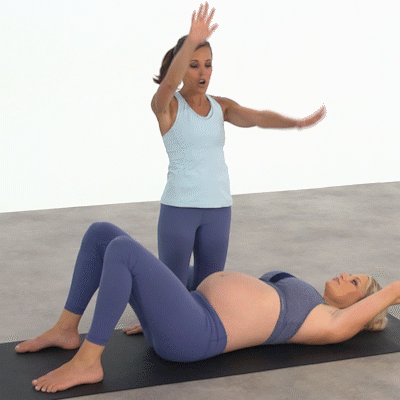
ARM SWITCH
Begin lying on your back with your knees bent, feet resting on the floor. Tighten your abdominals, drawing your navel in towards your spine — “hug your baby” with your belly muscles. Your pelvis should not tilt. Hold this position, as you switch your arms overhead.
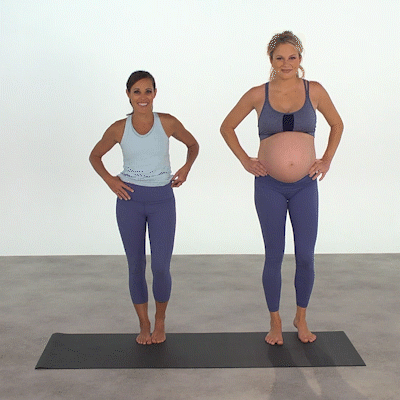
TRANSVERSE ABS HIP HIKE
Wonderful for third trimester! But also a key exercise throughout your pregnancy.
Shift your weight to one leg, straighten that leg. Grab a countertop if you feel off balance. Inhale, then as you exhale lift your hip using your deep abs to stabilize the pelvis and spine.